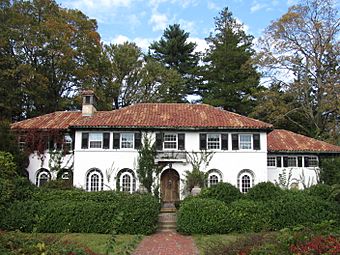Commonwealth Avenue Historic District (Newton, Massachusetts) facts for kids
Quick facts for kids |
|
|
Commonwealth Avenue Historic District
|
|

Corner of Commonwealth Avenue and Hammond Street
|
|
| Location | Roughly Commonwealth Ave. from Walnut St. to Waban Hill Rd., Newton, Massachusetts |
|---|---|
| Area | 55.85 acres (22.60 ha) |
| Architect | Multiple |
| Architectural style | Late 19th And 20th Century Revivals, Late Victorian |
| MPS | Newton MRA |
| NRHP reference No. | 90000012 |
| Added to NRHP | February 16, 1990 |
The Commonwealth Avenue Historic District is a special area in Newton, Massachusetts. It covers a big part of Commonwealth Avenue. This road stretches from Waban Hill Road, near the border with Boston, all the way west to Walnut Street.
The road itself was built in 1894 and finished in 1895. Its design was shaped by local people who gave land for it. It was also influenced by parts of the road in Boston, where famous landscape architect Frederick Law Olmsted helped with the design. After the road was built, many large, fancy homes were constructed along it. Most of these houses were built between 1895 and 1920. The district includes 188 homes, mostly built in popular styles from the early 1900s. This historic area was added to the National Register of Historic Places in 1990.
Exploring Commonwealth Avenue's History
Commonwealth Avenue in Newton was created in 1895. It was an extension of a wide, tree-lined road (called a boulevard) that already existed in Boston. The goal was to help people travel through the center of Newton. It also provided service for cars and streetcars, which are like electric trains that run on city streets. This area wasn't well-served by other transportation at the time.
The design of Commonwealth Avenue in Newton was similar to the Boston part of the road and Beacon Street in Brookline. It was a wide road with space for a streetcar line. The Commonwealth Avenue Street Railway connected with the Boston Elevated Railway streetcars near the Newton-Boston border, close to Boston College.
However, Commonwealth Avenue in Newton is different from those other roads. The land here is much hillier. This means the road winds and curves in a more scenic way. Also, the city of Newton preferred single-family homes, not large apartment buildings.
Who Designed the Homes?
Many of the houses along Commonwealth Avenue were designed by skilled architects. One of the most active architects was Harry Morton Ramsay. He designed at least 17 homes in the district! Ramsay used many different styles in his work. The most common style he used for these homes was the Colonial Revival. This style brought back popular designs from America's colonial past.
Most of these beautiful houses were built for wealthy business people and professionals from Boston. There are also two small areas along the road where shops and businesses were built. One is near the eastern end, close to Boston College. The other is at the corner of Centre Street.



